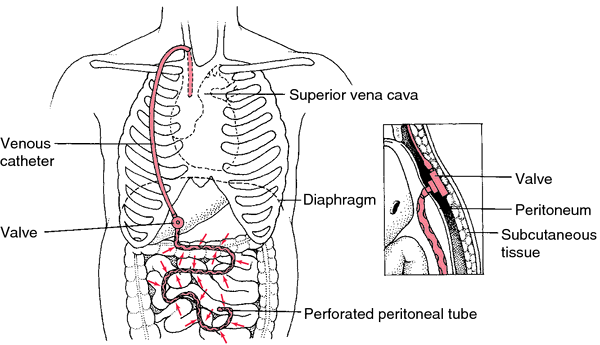Medical term:
ventriculoatriostomy
shunt
[shunt]1. to turn to one side; to divert; to bypass.
2. a passage or anastomosis between two natural channels, especially between blood vessels. Such structures may be formed physiologically (e.g., to bypass a thrombosis), or they may be structural anomalies.
3. a surgical anastomosis.
arteriovenous shunt a U-shaped plastic tube inserted between an artery and a vein (usually between the radial artery and cephalic vein), bypassing the capillary network, a formerly common means of arteriovenous access.
cardiovascular shunt an abnormality of the blood flow between the sides of the heart or between the systemic and pulmonary circulation; see left-to-right shunt and right-to-left shunt.
jejunoileal shunt an intestinal bypass performed to control obesity.
left-to-right shunt diversion of blood from the left side of the heart to the right side, or from the systemic to the pulmonary circulation through an anomalous opening such as a septal defect or patent ductus arteriosus.
LeVeen shunt peritoneovenous shunt.
mesocaval shunt a portosystemic shunt between the superior mesenteric vein and the inferior vena cava to reduce portal hypertension.
peritoneovenous shunt a device whose purpose is to remove excess ascitic fluid from the peritoneal cavity and return it to the venous system; called also LeVeen shunt.
The shunt consists of a peritoneal tube, a one-way valve, and a tube leading to a large vein, usually the superior vena cava or the jugular vein. The perforated peritoneal tube is placed in the peritoneal cavity and attached to the one-way valve which opens at a pressure of 3 cm H2O. The valve controls the direction of the flow of ascitic fluid and prevents a backflow of blood from the vein. A tube leading from the valve empties into the venous system.
The shunt is triggered into action by the patient's breathing. Upon inspiration, the diaphragm descends toward the abdominal cavity and causes a rise in fluid pressure in the thoracic superior vena cava. The difference in pressure, usually about 5 cm H2O, opens the shunt valve, allowing the flow of ascitic fluid into the large vein. The action of the shunt can be enhanced by the patient's inspiring against pressure, as when using a blow bottle.
A disadvantage of the shunt is dilution of the blood and a resultant drop in hematocrit, which necessitates transfusion of packed cells and perhaps a slowing of the rate of flow of ascitic fluid into the venous system. Other inherent risks are infection, leakage of ascitic fluid from the operative site, elevated bilirubin, gastrointestinal bleeding, and disseminated intravascular coagulation.
The shunt consists of a peritoneal tube, a one-way valve, and a tube leading to a large vein, usually the superior vena cava or the jugular vein. The perforated peritoneal tube is placed in the peritoneal cavity and attached to the one-way valve which opens at a pressure of 3 cm H2O. The valve controls the direction of the flow of ascitic fluid and prevents a backflow of blood from the vein. A tube leading from the valve empties into the venous system.
The shunt is triggered into action by the patient's breathing. Upon inspiration, the diaphragm descends toward the abdominal cavity and causes a rise in fluid pressure in the thoracic superior vena cava. The difference in pressure, usually about 5 cm H2O, opens the shunt valve, allowing the flow of ascitic fluid into the large vein. The action of the shunt can be enhanced by the patient's inspiring against pressure, as when using a blow bottle.
A disadvantage of the shunt is dilution of the blood and a resultant drop in hematocrit, which necessitates transfusion of packed cells and perhaps a slowing of the rate of flow of ascitic fluid into the venous system. Other inherent risks are infection, leakage of ascitic fluid from the operative site, elevated bilirubin, gastrointestinal bleeding, and disseminated intravascular coagulation.

Peritoneovenous (LeVeen) shunt for chronic ascites moves fluid from the peritoneal (abdominal) cavity into the superior vena cava. From Ignatavicius and Workman, 2000.
portacaval shunt a portosystemic shunt between the portal vein and the vena cava.
portosystemic shunt a surgically created shunt that connects the portal and systemic circulations, such as a mesocaval, portacaval, or splenorenal shunt.
postcaval shunt portacaval shunt.
pulmonary shunt an anomaly in which blood moves from the venous circulation to the arterial circulation without participating in gas exchange, resulting in hypoxemia.
reversed shunt right-to-left shunt.
right-to-left shunt diversion of blood from the right side of the heart to the left side or from the pulmonary to the systemic circulation through an anomalous opening such as septal defect or patent ductus arteriosus.
splenorenal shunt an anastomosis of the splenic vein and the left renal vein, created to lower portal hypertension following splenectomy.
ventriculoatrial shunt the surgical creation of a communication between a cerebral ventricle and a cardiac atrium by means of a plastic tube; done for relief of hydrocephalus.
ventriculoperitoneal shunt a communication between a cerebral ventricle and the peritoneum by means of plastic tubing; done for the relief of hydrocephalus.
ventriculovenous shunt a communication between a lateral ventricle and the venous system by means of a plastic tube; done for relief of hydrocephalus.
Miller-Keane Encyclopedia and Dictionary of Medicine, Nursing, and Allied Health, Seventh Edition. © 2003 by Saunders, an imprint of Elsevier, Inc. All rights reserved.
ven·tric·u·lo·a·tri·al shunt
(ven-trik'yū-lō-ā'trē-ăl shŭnt)Surgical procedure for hydrocephalus; a drain implanted in the lateral cerebral ventricle passes excess cerebrospinal fluid to the right atrium.
Synonym(s): ventriculoatriostomy.
Synonym(s): ventriculoatriostomy.
Medical Dictionary for the Health Professions and Nursing © Farlex 2012
ven·tric·u·lo·a·tri·al shunt
(ven-trik'yū-lō-ā'trē-ăl shŭnt)Surgical procedure for hydrocephalus.
Synonym(s): ventriculoatriostomy.
Synonym(s): ventriculoatriostomy.
Medical Dictionary for the Dental Professions © Farlex 2012
Latest Searches:
antimitotic - antimetabolites - antilogous - antileishmanial - antihelmintic - antifibrotic - antiendotoxin - anticoagulative - anticoagulant - anticholelithogenic - antiasthmatics - antianxiety - antiantibody - anthropical - anthraquinone - anteorbital - Anorgasmy - anociassociation - ankerite - anitrogenous -
- Service manuals - MBI Corp